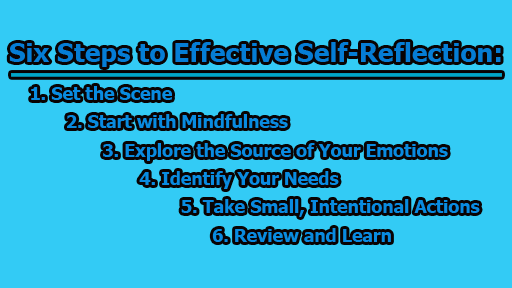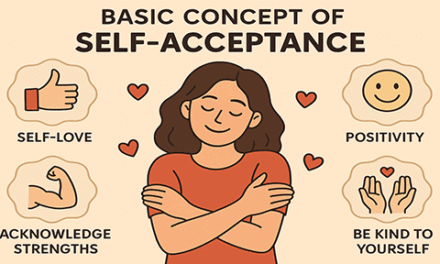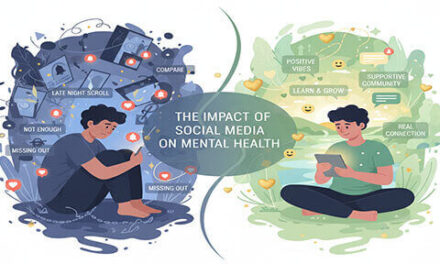Six Steps to Effective Self-Reflection:
In our fast-paced, always-connected world, it’s easy to get caught up in the hustle and lose sight of ourselves. That’s where self-reflection comes in—a simple but powerful practice that allows us to step back, check in with our feelings, and realign with what truly matters. It’s not just about thinking deeply but about understanding ourselves better, identifying unmet needs, and taking intentional steps to grow. Self-reflection is a tool for personal clarity, emotional balance, and purposeful living. In the rest of this article, we will explore the six steps to effective Self-Reflection, leading to deeper self-awareness and personal growth.
What is Self-Reflection and Why Does It Matter?
At its core, self-reflection is the act of pausing to examine your emotions, thoughts, and behaviors. It’s a chance to ask, “Why do I feel this way? What’s driving my actions? Am I living in line with my values?” It’s not just a mental check-in; it’s a way to better understand yourself and create a more intentional life.
Think of self-reflection as a way to reconnect with your inner compass. It helps you identify what’s working, what’s not, and what changes you need to make. It also fosters emotional intelligence, reduces stress, and enhances decision-making. The beauty of self-reflection is that it’s not about perfection but progress—about understanding yourself better so you can move through life with clarity and purpose.
Six Steps to Effective Self-Reflection:
If you want to make self-reflection a regular habit, having a clear process can help. Here’s a step-by-step approach to guide you.
1. Set the Scene: The first step is finding the right environment. Reflection requires focus and stillness, so choose a quiet, comfortable space where you can be alone with your thoughts. This could be your favorite chair at home, a peaceful park bench, or even a cozy corner in a library.
How to create the right environment:
- Turn off your phone or put it on silent to avoid distractions.
- Choose a time when you won’t be interrupted—early mornings or evenings often work well.
- Have a notebook, journal, or digital device handy to jot down your thoughts.
- A calm setting allows you to tune out external noise and focus inward.
2. Start with Mindfulness: Before diving into reflection, take a moment to ground yourself in the present. A simple body scan can help you connect with your emotions and physical state.
Try this mindfulness exercise:
- Sit comfortably, close your eyes, and take a few deep breaths.
- Notice how your body feels. Is there tension in your shoulders? A tightness in your chest?
- Ask yourself, “What am I feeling right now?” and “Where do I notice these feelings in my body?”
Write down your observations. This mindful check-in helps you become more aware of the connection between your physical sensations and emotions, setting the stage for deeper reflection.
3. Explore the Source of Your Emotions: Once you’ve identified your feelings, take time to uncover where they’re coming from. Are they tied to a specific event, thought, or situation? Understanding the root of your emotions is key to making sense of them.
Questions to guide you:
- What recent events or interactions might have triggered these feelings?
- Are these emotions a reflection of my values, or are they shaped by external pressures?
By exploring the “why” behind your emotions, you can start to distinguish between feelings that align with your values and those that stem from outside influences.
4. Identify Your Needs: Every emotion points to a need—something you’re craving or lacking. For instance, stress might signal a need for rest, while loneliness could indicate a desire for connection. Recognizing these needs is a crucial part of self-reflection.
Ask yourself:
- What do I need most right now? (Examples: rest, connection, adventure, acknowledgment.)
- Are there unmet needs or boundaries I need to establish?
By acknowledging your needs, you can begin to address them proactively, which leads to a greater sense of balance and fulfillment.
5. Take Small, Intentional Actions: Reflection is valuable, but it becomes transformative when paired with action. Once you’ve identified your emotions and needs, think about one small step you can take to address them.
Examples of actionable steps:
- If you’re feeling overwhelmed, schedule a 15-minute break to relax.
- If you’re feeling disconnected, call or text a loved one to reconnect.
- If you’re feeling stuck, set a small, achievable goal to regain momentum.
You don’t have to overhaul your life in one day. Small, intentional actions can create meaningful shifts over time.
6. Review and Learn: The final step is looking back on your reflection and assessing its impact. How do you feel now compared to when you started? What insights have you gained?
Questions to review your experience:
- What did I learn about myself during this reflection?
- How do I feel now, emotionally and physically?
- Is there anything I want to carry forward into tomorrow?
Writing down your thoughts and lessons can help solidify them and give you something to revisit in the future. Over time, these reviews will help you track your growth and see patterns that inform your next steps.
Why Regular Self-Reflection Is Worth It:
Making self-reflection a habit can transform your life in subtle yet powerful ways. Here are some of the key benefits:
- Improved Emotional Awareness: You’ll better understand your feelings and how to manage them.
- Stronger Relationships: Reflection helps you communicate more effectively and empathize with others.
- Greater Resilience: By identifying your needs and taking action, you’ll feel more equipped to handle challenges.
- Alignment with Your Values: Reflection ensures your actions stay true to what matters most to you.
Tips to Make Reflection a Sustainable Habit:
- Start Small: Even five minutes of daily reflection can make a difference.
- Use Prompts: Questions like “What did I learn today?” or “What am I grateful for?” can guide your thoughts.
- Be Kind to Yourself: Self-reflection isn’t about judging yourself; it’s about learning and growing.
- Experiment: Try different methods—journaling, meditation, or talking things through with a friend.
It is apparent that self-reflection isn’t about dwelling on the past—it’s about understanding yourself in the present so you can build a better future. By following above six-step process, you can turn reflection into a powerful tool for self-awareness, growth, and alignment with your values.
The journey of self-reflection is deeply personal, but its rewards are universal. Take a moment today to pause, look inward, and connect with what truly matters. You might be surprised by what you discover.

Library Lecturer at Nurul Amin Degree College










